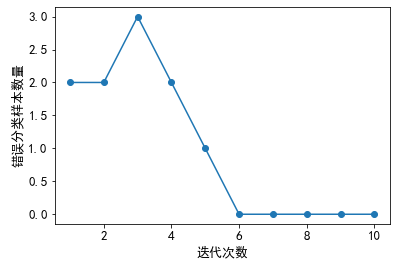Python机器学习2.2
使用Python实现感知器学习算法
在《Python机器学习》中的2.2节中,创建了罗森布拉特感知器的类,通过fit方法初始化权重self.w_,再fit方法循环迭代样本,更新权重,使用predict方法计算类标,将每轮迭代中错误分类样本的数量存放于列表self.errors_中。罗森布拉特感知器可以参考这个网址或自行百度。https://www.jb51.net/article/130970.htm

1 import numpy as np 2 class Perceptron(object): 3 """感知器分类器. 4 5 参数 6 ---------- 7 eta(学习速率) : float 8 学习率(介于0和1之间) 9 n_iter(迭代次数) : int 10 通过训练数据集. 11 12 属性 13 ---------- 14 w_ : id-array 15 fit方法后的权重. 16 errors_ : list 17 每轮迭代错误分类样本的数量存放列表. 18 19 """ 20 def __init__(self, eta=0.01, n_iter=10): 21 self.eta = eta 22 self.n_iter = n_iter 23 24 def fit(self, X, y): 25 """拟合训练数据. 26 27 参数 28 ---------- 29 X : {array-like}, shape = {n_samples, n_features} 30 训练向量, 其中n_samples是样本的数目, 31 n_features是特征的数目(维数). 32 y : array-like, shape = {n_samples} 33 目标值. 34 35 返回 36 ---------- 37 self : object 38 39 """ 40 self.w_ = np.zeros(1 + X.shape[1]) 41 self.errors_ = [] 42 43 for _ in range(self.n_iter): 44 errors = 0 45 for xi, target in zip(X, y): 46 update = self.eta * (target - self.predict(xi)) 47 self.w_[1:] += update * xi 48 self.w_[0] += update 49 errors += int(update != 0.0) 50 self.errors_.append(errors) 51 return self 52 53 def net_input(self, X): 54 """Calculate net input""" 55 return np.dot(X, self.w_[1:]) + self.w_[0] 56 57 def predict(self, X): 58 """每一步后返回类标签""" 59 return np.where(self.net_input(X) >= 0.0, 1, -1)
书中选用了鸢尾花数据集中的山鸢尾(Setosa)和变色鸢尾(Versicolor)俩种信息作为测试数据。出于可视化,选取了萼片长度(sepal length)和花瓣长度(petal-length)两个特征。
使用pandas库直接从UCI机器学习库中获取鸢尾花数据集(iris.data)并转换为DataFrame对象加载到内存中,使用tail方法显示数据确保正确加载。

import pandas as pd df = pd.read_csv('https://archive.ics.uci.edu/ml/' 'machine-learning-databases/iris/iris.data', header=None) df.tail()

提取前100个类标,其中山鸢尾(Setosa)和变色鸢尾(Versicolor)各50个,并将类标用两个整数表示:1表示变色鸢尾,-1表示山鸢尾,赋给NumPy的向量y。类似的,提取前100个训练样本的第一个特征列()和第三个特征列(),赋给X。用二位散点图进行可视化。

import matplotlib.pyplot as plt import numpy as np #jupyter notebook显示图片 %matplotlib inline #中文字体显示 plt.rc('font', family='SimHei', size=13) y = df.iloc[0:100, 4].values y = np.where(y == 'Iris-setosa', -1, 1) X = df.iloc[0:100, [0,2]].values plt.scatter(X[:50, 0], X[:50, 1], color='red', marker='o', label='setosa') plt.scatter(X[50:100, 0], X[50:100, 1], color='blue', marker='x', label='versicolor') plt.xlabel('花瓣长度(cm)') plt.ylabel('萼片长度(cm)') plt.legend(loc='upper left') plt.show()

利用抽取的鸢尾花数据子集训练感知器。绘制每次迭代错误分类数量的折线图。

1 ppn = Perceptron(eta=0.1, n_iter=10) 2 ppn.fit(X, y) 3 plt.plot(range(1, len(ppn.errors_) + 1), ppn.errors_, 4 marker='o') 5 plt.xlabel('迭代次数') 6 plt.ylabel('错误分类样本数量') 7 plt.show()

待续。。。




 浙公网安备 33010602011771号
浙公网安备 33010602011771号